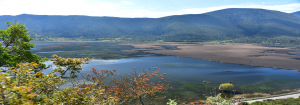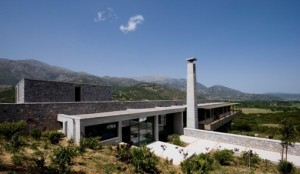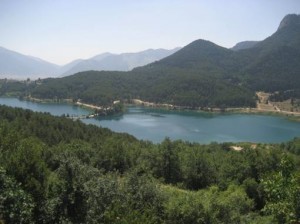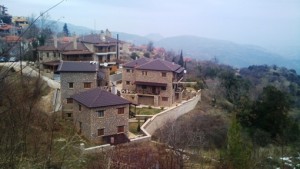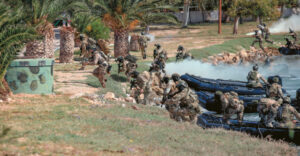Living or staying in Athens and dreaming of an escape to nature in the heart of the winter? Then take a break in the mountain area of Korinthos! Take the very comfortable motorway connecting Athens to Patras and in a matter of two hours you’ll see your dream come true!
Starting here
Stay in a place where you will be able to easily move around. We suggest Stympalia, Trikala, or the beautiful little town of Xylokastro, on the coast of Korinthos. The mountainous landscape, dotted with picturesque villages and beautified by two lakes, extends over the fir-clad slopes of Mt Ziria, the second biggest of Peloponnese to Taygetos. You’ll regret leaving the area without seeing and doing what we are hereby suggesting:
Stymphalia
This town has been built in the Killini (Cyllene at Ziria) mountain region and was renowned in mythology. According to the legend, Hercules slew the Stymphalian fowls, the man-eating birds with the bronze wings that lived in the swamps, on the lake’s banks of the same name. It is located 61 km W of the city of Korinthos.
Points of interest
– Lake Stymphalia is situated at an altitude of 700 metres between four mountains: Ziria, Oligirto, Mavrovounio and Gavria. It is considered to be a rare wetland habitat and hosts more than 143 species of birds, some of which are rare. It is worth stopping by at one of the bird observatories along the lakeside road.
– The ruins of the Ancient city of Stymphalos on the lake’s northern roadside where the remnants of the Ancient Agora’s public buildings, fortifications and temples have been discovered that bear testament to the past’s glory. The city which has been excavated was founded in approximately 350 B.C. on the site of a town with inter-dispersed ruins dating to the early and late Bronze Age period. The partial destruction of Stymphalos appears to be due to a Roman military attack after 146 B.C.
– The Environmental Museum of Stymphalia.
– The impressive Zaraka Cistercian Monastery ruins, a little outside the village, appear to be the first noteworthy evidence for the monastery, which date back to 1236. Its church (a three-aisled basilica roofed with groin vaults) has been excavated over three periods (1928, 1962, 1993-1997), while the columns are reminiscent of 13th century Gothic churches.
– The villages Kaliani (5 km E), Lafka (10 km SW) where a prominent museum operates with old tools, and Kastania (14 km W) are set in a magnificent landscape with chestnut, fir and plane trees. Take in the beauty of the area by mountaineering as some spots offer a breathtaking view to the lake.
Trikala
This market town has been built among the pine and fir tree forested slopes of Mount Cyllene (Ziria) and is one of the prefecture’s most popular mountain resorts. The three districts (Kato, Messea and Ano Trikala) are the ideal base for alternative tourism activities in the surrounding region. It is located 67 km W of the city of Korinthos.
Points of interest
– The churches of Agios Dimitrios (1697) and Agios Ioannis (1853) with the interesting murals (Kato Trikala), Metamorphosis tou Sotira (Mesaia Trikala, 9th century) and Agios Nikolaos with the notable 10th century murals (Ano Trikala).
– The ruins of the Notaras family mansion and the house where Saint Gerasimos was born at Ano Trikala.
– The Agios Vlasios monastery (17th century) is set in an evergreen environment.
– The rural chapel of Koimissi tis Theotokou (16th century) with the significant hagiographies and Byzantine icons.
– Flambouritsa valley, situated between the Megali and Mikri Ziria clusters, which together with the highest mountain peaks have been included in the “Natura 2000” European Union network.
– The cave of Hermes on the western side of Flambouritsa with the prominent stalagmite and stalactite decoration.
– Lake Kefalogianni on the eastern side and the Lake Dassiou on the western side of Ziria.
Feneos
The highland town has been built in a verdant setting close to the archaeological site. It has a marvellous square and stone built houses. It is 100 km to the west of the city of Korinthos.
Points of interest
– Ancient Feneos with the ruins of the Ancient city where you will see the relics of the temple of Asclepius and a section of the acropolis’ fortifications. The Archaeological Collection with findings from excavations in the region is on display at Kalivia (Ancient Feneos).
– The artificial lake Doxa has been formed by the Feneos-Doxa dam in the waters of the Olvios River. The region’s landscape is enchanting and it’s worth walking along the perimeter course. The (14th century) Paliomonastiro is located at the lake’s centre (linked to the shore by a narrow strip of land).
– The three-storey monastery of Agios Georgios (1693), very close to Lake Doxa, provides an impressive view of the region. During the Turkish Occupation, the monastery also operated as a “secret school” (the site has now been converted to a small museum). When there, don’t forget to have some of the tasteful spoon sweets from rose petals made by the monks themselves.
– The magnificent Feneos valley where potatoes, beans, lentils and walnuts of an exceptional quality are cultivated, which can be purchased from the region’s stores.
– The picturesque Ziria highland towns of Ano Tarsos (close to “Panagia Vrahou”, a small fortress city dating to the 14th-15th century), Kato Tarsos, Steno, Goura, Mesino and Mosia.
Activities
– Skiing, sleighs, snow mobiles at the Ziria Sports (Ski) Centre
– Mountaineering
– Canyoning
– Hiking along the organised and marked Ziria paths (total length of 55 km). The courses in the Lake Dasiou region and more specifically down to Karia village are will excite you
– Horse riding at the “Freestyle Horse Riding Centre” (at Rethi 4 km north of Kato Trikala)
– 4Χ4 Itineraries with the most interesting itinerary terminating at Goura village, crossing through Skafidia plateau (course length of 15 km), via the Mavros Longos fir tree forest
– Caving
– Paragliding
– Off-road trips with motorcycles
– Mountain bike riding from the Ziria Sports Centre to Lake Dasiou for a total length of 4.5 km
Source: visitgreece.gr
Ask me anything
Explore related questions

